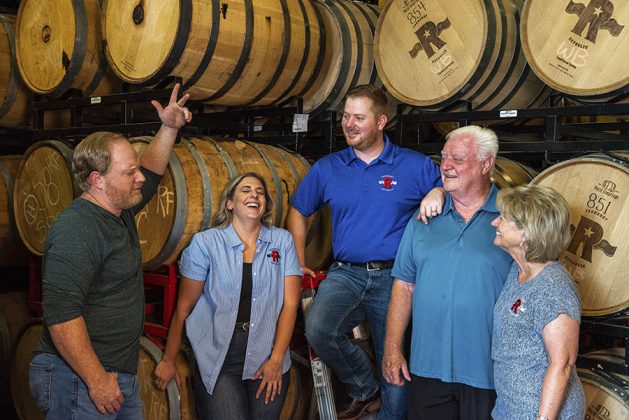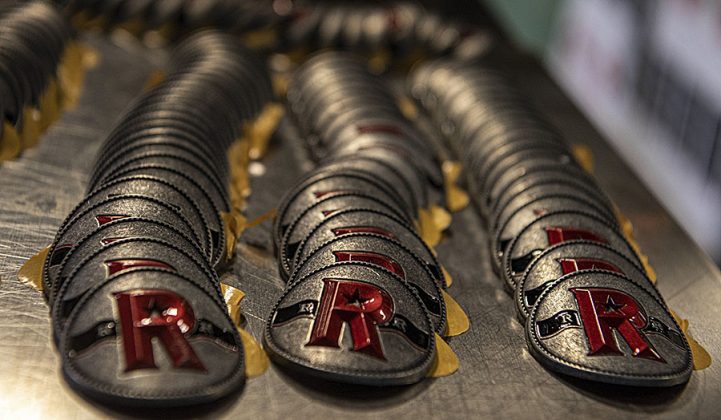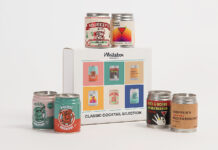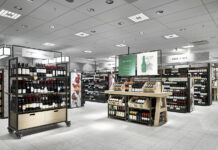The Ironroot Republic craft distilling success formula: Mix equal parts risk-taking, geography, industrial manufacturing expertise, strong family bonds, a wise and sympathetic banker, hard work, strong appetite for ADI workshops, a French connection, YouTube influencers, and a corn silo full of luck.
Meet the Likarish clan of Denison, Texas. The town of 22,000 is an hour north of Dallas; so close to the Oklahoma border that they call the region Texoma. Mom Marcia, an educator. Dad John, a smelter from copper king country in Butte, Montana. Second son Robert, a young lawyer. First son Jonathan, a double-degree engineer who built neurosurgery tools.
The Likarish distilling story starts at a family reunion in Spokane in the late 2000s. After a Thai dinner, the gang slid into the tasting room at Don Poffenroth’s Dry Fly Distilling on Trent Avenue in the Eastern Washington town. Dry Fly’s giant copper stills stirred Dad’s love of The Eternal Metal. Dad turned to the boys and told them, “In retirement, this is what you’ll do.”
Turns out, the boys couldn’t wait that long.
At Christmas dinner 2011, Robert announced he was swapping the bar exam for barreling. Then Jonathan dumped medical machines for the mash cooker.
“Might as well start when you’re young and dumb,” declared Robert.
Jonathan’s boss at the neurosurgical products company told him, “When you fail, you can always have your job back.”
Mom and Dad knew they couldn’t un-ring the booze bell. So they joined in. By the time Spring break arrived in 2012, Mom did what any good educator would do: She booked a field trip.
First stop, the farm-based Starlight Distillery in Starlight, Indiana, a pioneer in farm-to-bottle German wine grapes. The Starlight’s Huber family advised Robert to sign up for all the ADI classes he can find. As ADI students, they met famous nosing expert Nancy Fraley, and French brandy mentor Hubert Germain-Robain. Then it was on to Waco Texas to visit the Balcones distillery, then only four years old. Texas craft whiskey was in its infancy. When they compared field trip notes, four ideas jumped off the page. Each one was big.
The Four Big Ideas
The first idea was to be in north Texas. “It’s too hot in Houston,” said Robert. “Plus, in Austin there were several distilleries. But when we went to Dallas there were few venues, and lots of dry counties.” The boys knew that in booze, scarcity drives demand. People in dry counties drive to wet counties to quench their thirst. It’s a virtuous cycle for the craft spirit entrepreneur willing to take a risk.
The second idea is a history lesson. Click on the website of TSHAOnline.org, the Texas State Historical Association Handbook of Texas, and search Thomas Volney Munson (1843-1913). Even though Munson died a century ago, the Likarish clan calls him “TV,” like he’s part of the family, watching Netflix on the sofa on Thursday night.
TV Munson was a viticulturist, a wine grower who happened to live in Denison Texas. Because the Texas climate is harsh (think grasshoppers and African desert heat and hard winters), Munson cultivated local labrusca and vinifera grapes that were Texas tough and hard to kill. At the same time, in the 1890s, six million acres of French and German vineyards were lost from the fungus parasite oidium. And when French vintners tried to transfer them to the US, phylloxera plant louse killed the vines. So Munson shipped his phylloxera-resistant stock to France, which were grafted with European vinifera.
Monson’s hardened Texas vines saved French winemaking. In 1898, Munson was the first American to receive the French Legion of Honor Chevalier du Merite Agricole, the world’s highest agricultural honor. As an unexpected benefit, TV’s accomplishments in Denison, Texas created a natural and historical market for grape-based alcohols in Texas, including brandy and cognac. Local Grayson Community College (see sidebar) established a Thomas Volney Munson Memorial Vineyard and curriculum to train the next generation of Texas craft beverage leaders.
Natural result: Cognac in France and Denison are now sister cities. The brothers met the leadership at the big dog in French brandy, Martel. Robert and Marcia even managed to distill cognac in France’s Cognac region. “That’s a big deal for a little guy from Denison Texas,” said Robert. The French connection formed the basis for Ironroot Republic’s distilling methods.
The third big idea grew out of the second. The distillery’s name Ironroot Republic came from TV Munson’s innovation, the Texas “iron root” vine. In grapes at least, “Texas Strong” is actually a thing.
The fourth idea is where mash meets cash. “We learned that the difference between a clear liquor and an aged liquor is the difference between a checking account and a savings account,” said Robert. If you can sell the liquor immediately, that’s your checking account. If you have to lay it down, that’s savings. “Those laid-down assets are illiquid. I can’t touch the money for two to four years.”
That insight led the boys to a BGO—a Blinding Glimpse of the Obvious: Bankers are allergic to those non-liquid assets.
Booze and Banks
The boys honored that BGO. Ironroot Republic’s first products were clear spirits, a vodka and moonshine. “Of course, to distinguish ourselves we did a crazy style of vodka that we can sell immediately. It was a non-chill-filtered vodka with roasted grains called Blue Northern vodka,” Jonathan explained. “We matched that with Carpenter’s Bluff moonshine, which won a gold at the ADI awards.”
The boys knew their bottles were bankable. But the first banks they met had beer brain. “Banks in Texas are confused by the business of laying down bourbon,” Jonathan observed. “At the time we started, there few distilleries, but lots of brewers. Brewers get cash at the tap. Banks understand that model.”
After kissing a lot finance frogs, Ironroot found its prince–a savvy community banker named Robert Crawley at American Bank of Texas, now badged First United Bank. Robert admits, “He’s the only reason we’re here now.” Marcia adds, “Robert Crawley still supports us every day. He has kids the same age as Robert and Jonathan. They live in Austin, and his kids helped their father the banker identify the craft distillery trend. The most finance-friendly fact for Crawley was how local distilleries revitalize communities.” That speaks to a banker’s heart. Ironroot Republic got its credit line.
Marcia adds that the best time to hunt for money is when you do not need it. “If we didn’t have some money or assets, we wouldn’t have gotten any attention,” said Marcia. “Later, we had fewer assets and cash, but at least we had the bank’s support. It’s counter-intuitive, but you have to understand banker logic.”
Failing Fast
Jonathan Likarish threatens to write a book on how NOT to start a distillery. Struggles came early and often. The owner of the building they were buying was uninsured when he crashed through a fence, causing a long pause. The federal government shutdown ground their license process to a halt. Their mash tank was crushed. Twice. Their chilling system and boiler manufacturer teams turned over several times, resulting in a roller coaster ride of shutdowns.
“Our water in Denison has Total Dissolved Solids of 600 to 1,200 parts per million, versus a 300 TDS in Dallas, which causes lots of havoc on boilers. And we didn’t get good technical support in our first years,” Robert explained. For example, their chiller design did not take hot Texas summers into account, so they could only run at night. “Normally a run was 12 to 14 hours,” Jonathan explained. “Instead, we had to make our runs softer and extend them to 18 hours. It was a two-man 24-hour operation.” When their new chiller broke a pipe, it dumped a thousand gallons of cold water on Jonathan’s office floor. “That was very cold surprise at three in the morning.”
For their still-buying decision, the boys avoided disaster by listening to Dad, the copper smelter. When looking at a 500-gallon still, Dad saw the same challenge as in smelting. “He told us that upgrading is expensive and potentially deadly to a manufacturing operation,” Jonathan recalled. “So he advised to get the bigger size, which you can run at lower volume early on. As a result, Vendome was able to give us a 1200-gallon still, which has been the key to growth. Some distillers actually die growing. We were also fortunate that we were able to get the larger still earlier, only four months from order to delivery, which was just dumb luck. If we had gone with the smaller still, we would have waited longer for the first still, then when we were ready to grow, we’d wait another two years. And if we had to switch equipment, we would have large age-statement gaps in the barrels we lay down, which is another growth-crushing fail for distilleries.”
For their first nine months in business, the brothers failed to stay in their separate swim lanes, and nearly drowned. “I should have trusted Jonathan more,” admits Robert. “We should have started with rum. And because we didn’t know what our aged stuff would taste like, we didn’t lay enough down.” In month ten, Marcia saw the boys floundering and knew she needed to step in to run the business side of the operation. “If we had to do over, we would have brought her in from day one,” Jonathan admits. “The place doesn’t work without her. And we didn’t know that she had such great sales chops.” On her role keeping cash flow under control, Marcia adds, “Stills are beautiful, but it’s like feeding a hungry horse.” Also, for safety, Marcia instituted the rule that there always needs to be two people at the distillery. “You never know when you’ll need to call 911 or shut it down,” she said.
Likarish Luck
Thomas Jefferson, America’s third President famously said, “I find that the harder I work, the more luck I seem to have.” The Likarish brothers can relate.
For starters, take their decisions on location. Their hard work made them luckier.
They looked at lots of towns. Then picked an unlikely one. But Denison, Texas had the TV Munson viticultural heritage, the French connection, low operating costs, and it is a crossroads for millions of Texans and Oklahomans. Fifteen-hundred-room Chocktaw Casino is 20 miles away. Lake Texoma, a multi-million-visitor vacation spot is nearby. As Robert observed, “In Texas, everything is an hour away anyway. Most of the lake and casino traffic passes us on Highway 75.”
They decided to buy a building in Denison, a more expensive proposition than renting. That decision came from hearing distiller horror stories. “We learned that distilleries can be put out of business by a landlord who increases the rent, usually in year three,” Marcia said. “That, plus a building is good collateral when need to borrow later.”
Then the brothers worked hard on unconventional distribution and marketing choices, which led to more luck.
They vowed not to focus on on-premise sales via their own tasting room, restaurants and bars. “Our tasting room only does cocktails once a month, and we spend all our time building retail distribution,” said Robert. “Restaurants and bars are only five percent of our business. That saved us during COVID. While our heart goes out to the restaurants and bars, we kept growing during the pandemic.” Ironroot Republic will sell 9,000 cases in 2021, double their 2020 sales. Pre-2018 the distillery sold 2,000 cases.
They entered every competition that would have them, even when they faced David versus Goliath odds. That willingness to compete paid big dividends in February 2020 when their Harbinger Straight Bourbon won “World’s Best Bourbon” at the World Whiskies Awards, the first non-Kentucky bottle to win. “Forbes Magazine then covered us, and everything we made got sold out in 48 hours,” master distiller Jonathan remembered. “The bad news was we had no bottles saved. It was a positive problem.”
They cultivated YouTube influencers, a job for which Millenial Robert is uniquely qualified. “We got attention from Whiskey Tribes and Whisky Marketing School’s Daniel Whittington who we met at Nancy Fraley’s class at ADI. Then there are the Scotch Test Dummies, and Jason Callori from The Mash and Drum, and Chris Trevino at the Liquor Hound, known as the finest palate in Texas. They’ve all pushed us hard. The Whiskey Tube has really blown up. Whiskey Tribes now has like 400,000 subscribers. The secret sauce for YouTubers is there is no secret sauce. It’s a conversation, being part of their club, going to their livestreams. It has to be genuine. Years before it was all about sending bottles. But now it’s truly about actual interest in the Tubers and the conversation. It’s not about selling. It’s about being a fan, celebrating all of what’s going on. I spend many hours every week watching YouTube and channels.”
Then there’s their hard-won and fortunate formulation and flavor decisions.
In Texas, the team noted that the local climate’s impact on maturity has led to local acceptance of younger bourbons—two and a half to four years rather than four to six years. For their mash, they use heirloom corn. “In our third distillation we used blood butcher corn,” Jonathan recounts. “Now we use twenty species of corn including rainbow colors, and it’s amazing to see the combinations of proteins. Marcia is our green thumb, and she has grown some of the new corns we use.”
Friends and Trends
To see what’s ahead, the brothers track trends. In master distiller Jonathan’s opinion, the top trend for craft distillers is ready-to-drink, aka RTD. Nielsen IQ reported that hard seltzer sales hit $4 billion in 2020, up from $500 million in 2018. In addition, pre-mixed RTD cocktails are projected to hit $728 million in 2021 and will grow to $1.63 billion by 2027. For example, Spokane’s Dry Fly Distilling, where the Likarish brothers first caught the distilling bug in 2011, now offers “packable cocktails” in a can featuring their award-winning spirits. “Our friends at Garrison Brothers, the first legal craft distillery in Texas, now have a RTD pouch version. Kind of looks like one of those juice pouches in lunch boxes,” Jonathan noted. “RTD is a way to control cocktail mixing, so consumers get a positive flavor experience without having any bartender skills. And RTD is a cash flow booster and a market expander, because it lets you sell to someone who may not buy a bottle of your straight product.”
The second up-and-coming trend is direct-to-consumer, or DTC. An ADI survey of 269 distilleries in January indicated that DTC generated 39 percent of total sales for those who are in DTC states such as Alaska, California, Connecticut, Idaho, Nebraska, Nevada, New Hampshire, New Mexico, North Dakota, and cocktail-to-go states, including D.C., Iowa, Ohio and Kentucky. “For Texas, DTC is a long way off,” notes Jonathan. “But in smaller states DTC is a much bigger push. And independent bottlers can now ship, like our friends at Lost Lantern Whiskey, a big boon for them. We’re also seeing DTC combined with collaboration blends, where multiple craft distilleries blend their products together. Ironroot has done collaborations. In collaborations, we’re following what the craft beer guys have done for years.”
And the flavor of craft distilling’s future? Tastes like Likarish.













